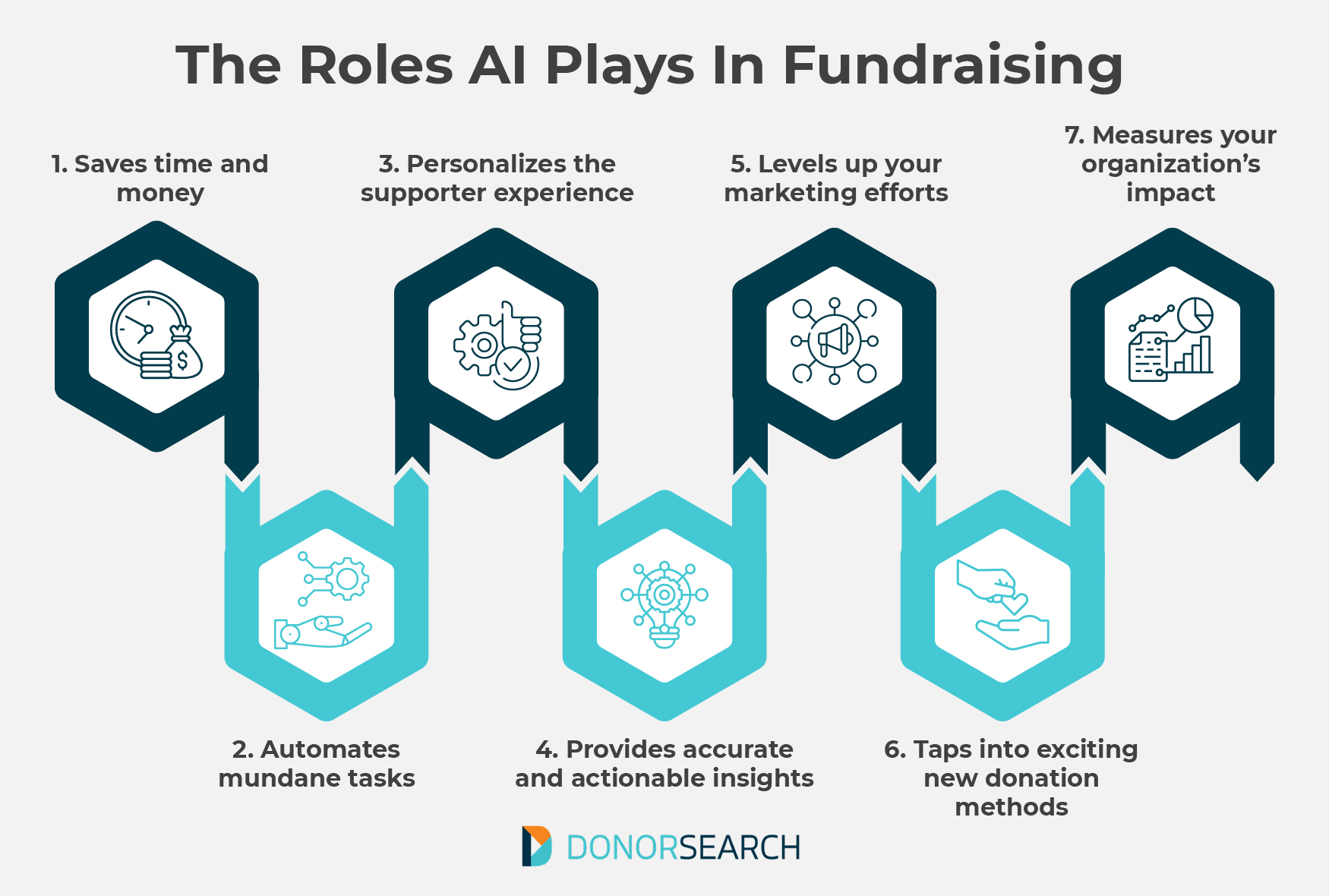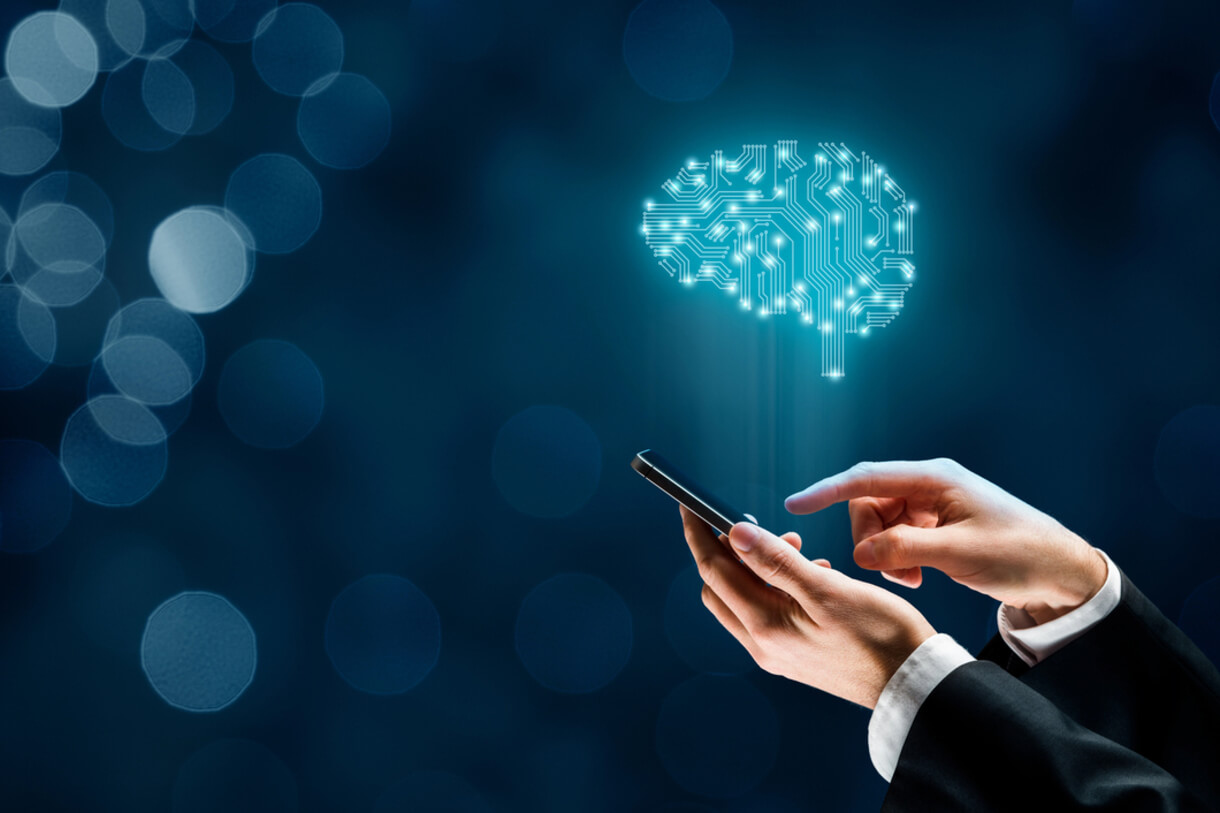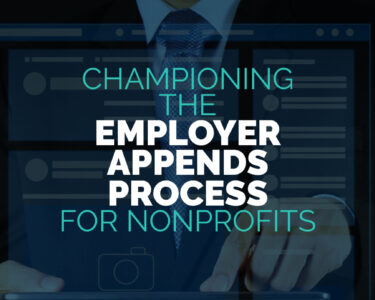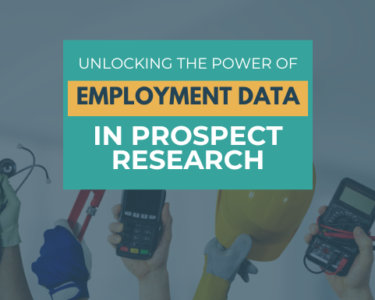
It’s no secret that artificial intelligence (AI) is growing in popularity for both personal and professional use. In fact, 77% of devices currently in use feature some form of AI, and 72% of organizations around the world leverage AI for at least one business function.
For nonprofits like yours, AI tools can boost your operations in a variety of areas, from fundraising to donor engagement to data management—that is, if you leverage the right types of solutions.
In this guide, we’ll look at three categories of AI tools that your organization would benefit most from utilizing. But first, let’s dive into some of the specific benefits of incorporating AI into your nonprofit’s work.
How AI Solutions Can Benefit Nonprofits
DonorSearch’s AI fundraising guide explains seven key roles that AI plays in nonprofit work. While this list is by no means exhaustive, adopting AI solutions at your organization will allow you to:

- Save time and money while delivering improved revenue generation and donor engagement results.
- Automate mundane tasks so your team can focus on more strategic responsibilities.
- Personalize the supporter experience by gaining a deeper understanding of your donors and reaching out in ways that resonate with them.
- Provide accurate and actionable insights so your leaders can make data-driven decisions.
- Level up your marketing efforts by efficiently creating high-quality, consistently branded, targeted, and accessible content (more on this later!).
- Tap into exciting new donation methods that your AI tools have brainstormed for you based on donor data.
- Measure your organization’s impact so you can prioritize what you’re doing well and identify opportunities for improvement.
Of course, all of these benefits are contingent upon whether your nonprofit uses AI responsibly. Like with any new technology, there are risks associated with improper AI use, which is likely why 52% of U.S. adults were more concerned than excited about AI’s prevalence as of 2023. Make sure your nonprofit adheres to AI-related legal regulations, follows data security best practices, actively works to prevent bias, and communicates transparently with supporters about its AI use to reinforce trust in your organization’s work.
Top Types of Nonprofit AI Tools
Now that you know why your organization should consider using AI and how to properly implement it, let’s look at the most helpful types of AI solutions for nonprofits in more detail.
Predictive Modeling
As AI tools process greater amounts of information, they get better at recognizing patterns in and drawing conclusions from the available data through a process known as machine learning. Predictive modeling solutions for nonprofits use their machine learning capabilities to visualize donor data, segment current and potential supporters, and prioritize your outreach lists based on data-informed probabilities.
Predictive modeling is most useful for your organization when you’re conducting prospect research to identify potential major and planned donors. Basically, what happens is:
- Your team uses your nonprofit’s donor database and third-party prospect research databases to gather a variety of wealth and philanthropic information on possible high-impact donors.
- Your predictive modeling tool processes this data and assigns ratings to each prospect based on their likelihood of responding to outreach, making a first gift, and becoming long-term supporters of your organization (among other factors).
- You get access to data visualizations of these ratings and a prioritized prospect list so you know which potential donors to reach out to first about contributing to your most pressing initiatives.
Essentially, predictive modeling tools allow you to grow your supporter base by working smarter, not harder. When you know which prospects are likely to engage with your nonprofit, you can put less time and resources into cultivation while securing more of the large gifts that provide critical support for your mission.
Prospect Reporting
AI-driven prospect reporting is also useful for cultivating major and planned donors. While predictive modeling looks at prospects’ information within the context of your larger pool of potential donors, prospect reports provide insights into each individual supporter at a glance, such as their:
- Demographic information
- Interests and values
- Personal, professional, and nonprofit-specific connections
- Wealth insights
- Philanthropic history with your organization and other nonprofits
- Predictive modeling ratings
- Responses to past communications
Prospect reports lay the foundation for moves management fundraising, which is a strategic approach to building donor and prospect relationships. Since the key to effective moves management is tailoring your approach to align with each supporter’s unique background and preferences, these reports allow you to plan your next moves for each donor quickly and easily. Then, as you track response data throughout the process and adjust your strategy, you can combine that information with AI insights to develop a solid fundraising ask for each donor.
Content Generation
If you’re familiar with any AI solution, you likely know about content generation tools—think of ChatGPT or Grammarly, for example. These solutions and others (both general and nonprofit-specific tools) can help your nonprofit develop many different types of content, including:
- Copy for website pages, emails, and direct mail messages.
- Social media post ideas, captions, and schedules.
- Professional-looking videos for various channels.
- Infographics that organize complicated data in digestible formats.
- Compelling calls to action to make the intended next steps clear in any marketing message.
- Slides and talking points for meetings with prospects and other stakeholders.
- Grant proposal drafts that align with funder requirements.
- Event planning documents and budgets.
- Supporter recognition materials—according to Winspire’s donor stewardship guide, these can range from handwritten thank-you notes to donor appreciation dinner invites to spotlights in your organization’s annual report.
- Content accessibility elements like alternative text for images, audio content transcripts, closed captions for videos, and other features that allow all users to gain value from your materials.
As you create content with AI tools, remember to always maintain human oversight and include personal touches within your messages. Use AI outputs as your starting point, then edit them to ensure they align with your nonprofit’s brand voice and target audience.
If your nonprofit chooses to use an AI solution that falls into any of the above categories, remember to work with trusted providers and thoroughly vet the tool to ensure it’ll work for your organization’s needs. Then, train your team on best practices for using the solution to maximize its long-term benefits to your nonprofit.
👇Follow more 👇
👉 bdphone.com
👉 ultraactivation.com
👉 trainingreferral.com
👉 shaplafood.com
👉 bangladeshi.help
👉 www.forexdhaka.com
👉 uncommunication.com
👉 ultra-sim.com
👉 forexdhaka.com
👉 ultrafxfund.com
👉 ultractivation.com
👉 bdphoneonline.com




